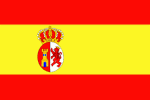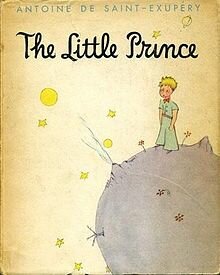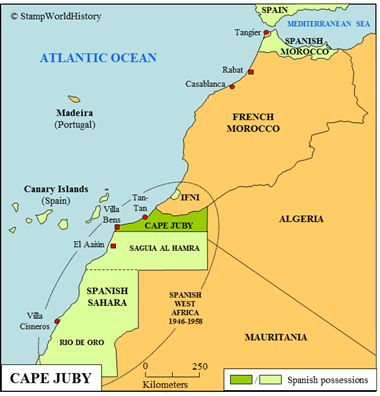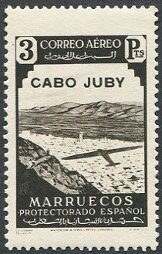
Cape Juby
Quick reference
General issues: Spanish protectorate 1916-1948
Country name on general issues: Cabo Jubi, Cabo Juby
Currency: 1 Peseta = 100 Centimos 1916-1948
Population: No period statistics available – numbers mentioned in resources suggest the population to have been less than 10 000
Political history Cape Juby
The facts
Cape Juby is located in northern Africa. Cape Juby is a sparsely populated desert country – the population being Berber, an Afro-Asiatic people found all across northern Africa. The territory of Cape Juby is, in 1912, awarded to Spain by way of a treaty with the French. In 1912, the French had established a protectorate over Morocco. A subsequent treaty with Spain results in the partition of Morocco, whereby France gains the larger part and Spain establishes a protectorate over a zone to the north of the French protectorate and a zone to the south of the French protectorate. The former is commonly called Spanish Morocco, the latter Cape Juby.
The Spanish effectively establish themselves in Cape Juby from 1916. Being adjacent to the Spanish possessions south of Morocco, it will de facto come to be governed, from 1924, as part of Spanish Sahara and, from 1946, as part of Spanish West Africa, although de jure remaining a separate political entity. The capital is Villa Bens.
When Morocco gained independence in 1956, the Spanish remained in possession of Cape Juby. Morocco ascertained its claims to the Spanish possessions to the south by military force in 1957-1958 and in 1958 Cape Juby was transferred to Morocco.
Currently Cape Juby is split up to be part of two provinces of modern Morocco. Villa Bens is now Tarfaya, a town with some 5 600 inhabitants in 2004.
Trivia or maybe more ……

The Little Prince – Translated into 250 languages – 140 million copies sold worldwide
Cape Juby is a remote place. Maybe the moment of glory for Cape Juby is the part it played in the pioneering days of postal air flight in the 1920’s. The airplanes of the time had a limited range and had to make frequent stop overs to refuel. A French company, Aéropostale, in 1927 arranged for Villa Bens to be one of the stopovers on the aerial route from Toulouse in France to Dakar in Senegal. Villa Bens served as such until 1931 when new airplanes with an increased range came into use and Capy Juby could be overflown.
Possibly one of the most famous expats to have served a term in Cape Juby was the writer Antoine de Saint-Exupéry – author of ‘The Little Prince’. Being an aviator by profession, he was stationed at Villa Bens in 1927-1928 as the stop over manager for Aéropostale. De Saint-Exupéry published The Little Prince in 1943.
Postal history Cape Juby
The first stamps for use in Cape Juby are issued in 1916. All stamps issued for Cape Juby are provisionals. The first set are overprints on stamps of Rio de Oro – the overprint being ‘Cabo Jubi’ and a new face value. Next, a few sets of Spanish stamps overprinted ‘Cabo Juby’ are issued and, from 1934, all overprints are on stamps of Spanish Morocco. A last set is issued in 1948. From 1950, Cape Juby is postally integrated with Spanish Sahara of which the stamps are used until 1958 when Cape Juby is transferred to Morocco.
Album pages
← Previous page: CameroonNext page: Cape of Good Hope →



